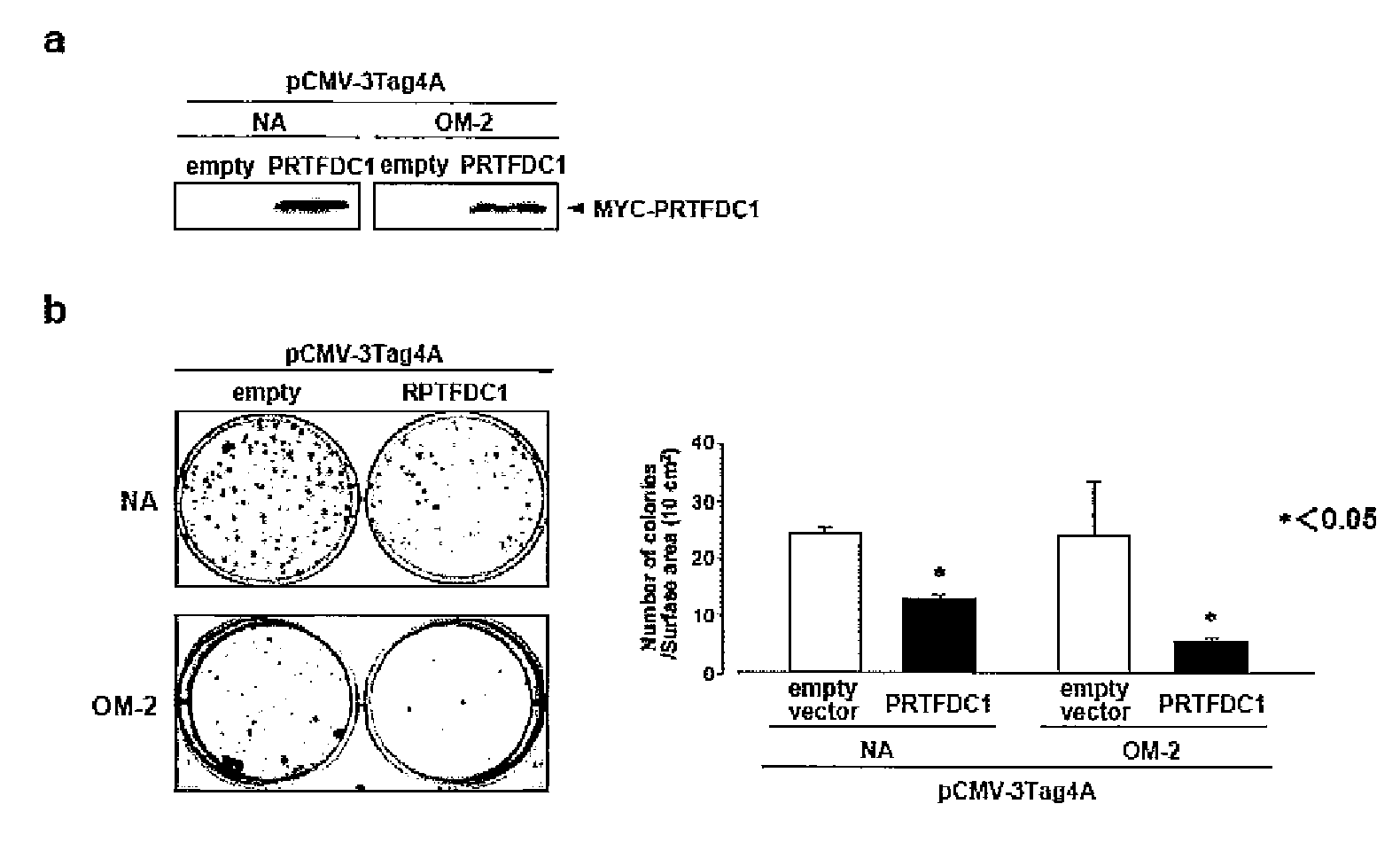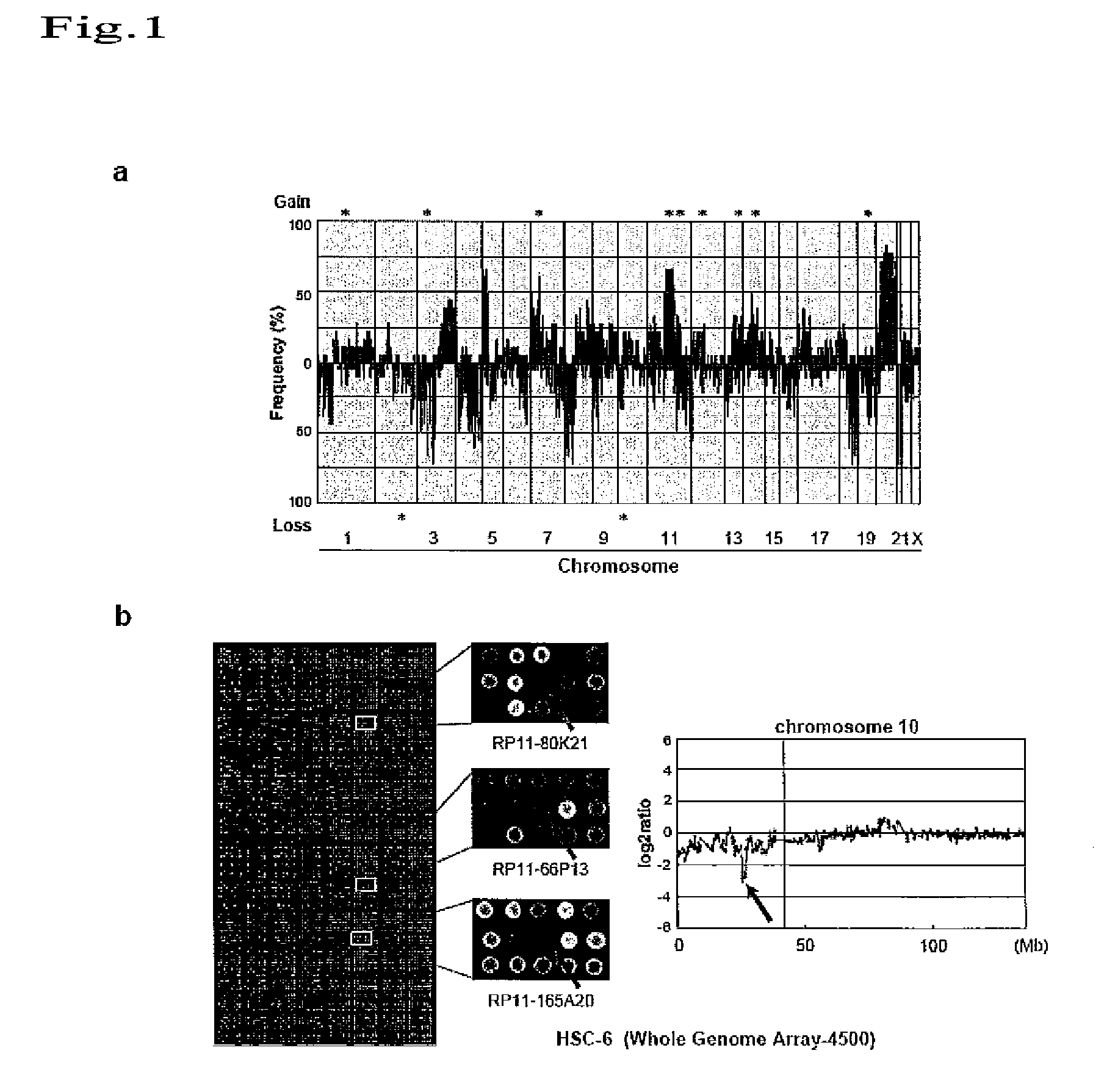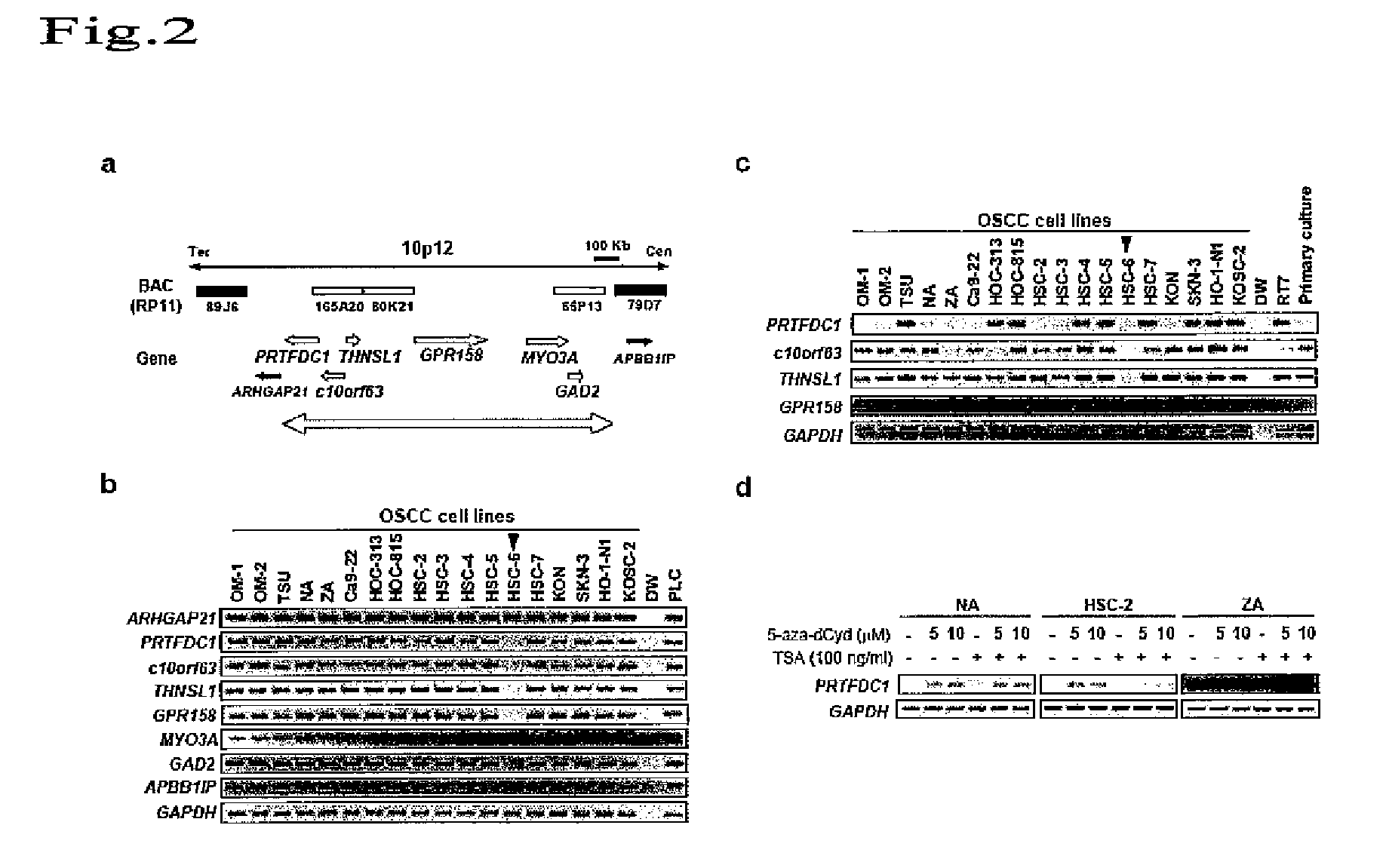Method for detecting oral squamous-cell carcinoma and method for suppressing the same
a technology for detection method, which is applied in the field of oral squamous cell carcinoma detection and the field of suppressing the same, can solve the problems of unimproved prognosis, achieve convenient and rapid analysis, promote oral squamous cell canceration, and reduce the protein of prtfdc1
- Summary
- Abstract
- Description
- Claims
- Application Information
AI Technical Summary
Benefits of technology
Problems solved by technology
Method used
Image
Examples
example 1
Gene Alteration in Oral Squamous-Cell Carcinoma
[0101]To detect a novel gene alteration in oral squamous-cell carcinoma, CGH array analysis was made using genomic DNAs prepared from 18 types of oral squamous-cell carcinoma cell line (OM-1, OM-2, TSU, ZA, NA, Ca9-22, HOC-313, HOC-815, HSC-2, HSC-3, HSC-4, HSC-5, HSC-6, HSC-7, KON, SKN-3, HO-1-N-1, and KOSC-2), and using MGC Cancer Array-800, and MGC Whole Genome Array-4500 (FIG. 1a). A genome extracted from the cell line (RT7) derived from normal oral epithelium was labeled with Cy5 as a control. Genomic DNAs prepared from the above oral squamous-cell carcinoma cell lines were used as test DNAs, and were labeled with Cy3. Specifically, each genomic DNA (0.5 μg) digested with Dpn II was labeled using a BioPrime Array CGH Genomic Labeling System (Invitrogen) in the presence of 0.6 mM dATP, 0.6 mM dTTP, 0.6 mM dGTP, 0.3 mM dCTP, and 0.3 mM Cy3-dCTP (oral squamous-cell carcinoma cells) or 0.3 mM Cy5-dCTP (normal cells). Cy3- and Cy5-label...
example 2
Isolation of Gene Contained in Deletion Region of Chromosome 10p12 of Oral Squamous-Cell Carcinoma
[0103]To determine a gene contained in a homozygous deletion region of chromosome 10p12 in oral squamous-cell carcinoma cells (HSC-6), the range of the homozygous deletion region was first determined by genomic PCR using HSC-6 cells. Table 3 shows primer sequences used in genomic PCR.
TABLE 3Supplementary Table 2. Primer sequences usedin this studyMethodTargetForward primerReverse primerGenomic PCRARHGAP215′-CACCTTGGCTT5′-GGTTGGGCATTCAACAAACAGCGCTGCAGPRTFDC15′-CTGGCCAAGGA5′-CCTTCATTGAGTATTATGAAAGACAAATCGATCc10orf635′-TATACCAAAGA5′-GTGTTCTAATAAGATCCGCAAGAATATAACGGTTATTHNSL15′-ATGCATTACCT5′-GATTTTGGACACCACTGCATGAGTTGTTCCACGPR1585′-ATATTGCTACA5′-TCCTCTGGATCGAAGCATATGAGCAAGCTGTGMYO3A5′-TTTGCCCAGTC5′-TTTACCTTTCAGTTCTGGACTTAGCCTTAATACGAD25′-TCCAGTGATTA5′-TTGCCGCTGGGAAGCCAGAATGTTTGAGATGAPBB1IP5′-CAAGAGGCAAG5′-AGGACACGTTGAGAACCCAGCCTCTCTTCGAPDH5′-AACGTGTCAGT5′-AGTGGGTGTCGGGTGGACCTGCTGTTGAAGRT-PC...
example 3
Disappearance of PRTFDC1 mRNA Expression in Oral Squamous-Cell Carcinoma Cell Lines
[0106]To examine the expression levels of the 6 above genes (the PRTFDC1 gene, the e10orf6 gene, the THNSL1 gene, the GPR158 gene, the MYO3A gene, and the GAD2 gene), 18 types of oral squamous-cell carcinoma cell line and normal oral epithelium cells were subjected to reverse transcriptase (RT)-PCR. Specifically, a single-chain cDNA was synthesized from the RNA extracted from each cultured cell line using the SuperScript First-Strand Synthesis System (Invitrogen). PCR was then performed using primer sequences listed in Table 4 (supplementary Table 1). Moreover, a glyceraldehyde-3-phosphate dehydrogenase (GAPDH) gene was used as a control. As a result, complete disappearance of PRTFDC1 mRNA expression could be confirmed in 8 cell lines in which homozygous deletion of chromosomal region 10p12 should not have taken place, as in the case of HSC-6 cells (FIG. 2c). Furthermore, HOC-313 cells showed a more s...
PUM
 Login to View More
Login to View More Abstract
Description
Claims
Application Information
 Login to View More
Login to View More - R&D
- Intellectual Property
- Life Sciences
- Materials
- Tech Scout
- Unparalleled Data Quality
- Higher Quality Content
- 60% Fewer Hallucinations
Browse by: Latest US Patents, China's latest patents, Technical Efficacy Thesaurus, Application Domain, Technology Topic, Popular Technical Reports.
© 2025 PatSnap. All rights reserved.Legal|Privacy policy|Modern Slavery Act Transparency Statement|Sitemap|About US| Contact US: help@patsnap.com



